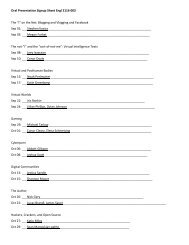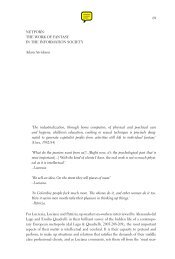Nakamura, Digitizing Race, Introduction, chapter 5, Epilogue
Nakamura, Digitizing Race, Introduction, chapter 5, Epilogue
Nakamura, Digitizing Race, Introduction, chapter 5, Epilogue
You also want an ePaper? Increase the reach of your titles
YUMPU automatically turns print PDFs into web optimized ePapers that Google loves.
92 Alllooksame?<br />
that such literature is “deracinated” and “Westernized.” 45 And all throughout<br />
his discussion in the New Yorker article titled “Damme, This Is the Oriental<br />
Scene for You!” in which he formulates this position, he makes no mention<br />
of race whatsoever. 46<br />
The rift between the two camps in postcolonial literary theory maps well<br />
onto the impasse between thinkers in postcolonial Internet theory. On the<br />
one hand, some fear miscegenation between media and worry that uneven<br />
encounters between “pure” non-Western cultural forms and “tainted” electronic<br />
media must necessarily result in a muddled, deracinated mediascape.<br />
Others seem to welcome the opportunity that multimedia may give them to<br />
produce new cultural forms which are hybrid, multicultural, and by implication<br />
multiracial. This is not to say that cultural authenticists are condemning<br />
racial muddling or mixing along with media muddling, or saying<br />
that one is the effect of the other, but rather that the rhetoric of purity and<br />
the discourse of “deracination” must evoke earlier discourses of “biological”<br />
purity and racial authenticity. Why are these colonial fears of racial and cultural<br />
miscegenation resurfacing in discussions of the Internet and new media?<br />
In a sense this set of concerns is moot, for the Internet is penetrating cultures,<br />
markets, ethnic groups, and genders at a tremendous clip in total<br />
defiance of what the critics think. However, the debates within postcolonial<br />
theory over language adoption can prove useful in parsing out the ways that<br />
new media can seek to avoid a seeming deadlock between contradictory<br />
positions. The fact is that there are few, perhaps no, media forms that are<br />
“purely” authentic, just as there are few that are homogeneously and uniformly<br />
hybrid. Media forms are bumpy, layered, and pitted with the imprint<br />
of contact with other cultures; none avoid the mark of imperialist power<br />
relations. And the Internet is no different. What the Internet does offer,<br />
however, is a range of imagistic and interactive practices that produce a distinctively<br />
different mediascape from the world of the static literary text. The<br />
potential of the Internet to transform visual cultures like India’s or at least<br />
to engage with them in ways that literary texts cannot must be examined if<br />
we wish to avoid repeating the same arguments regarding cultural purity<br />
versus cultural hybridity. This is a Hobson’s choice that would better be<br />
avoided for a number of reasons, not the least of which being that it fails to<br />
account for people who are not textually literate in any language, thus perpetuating<br />
the analog class and education divide. 47 Postcolonial debates that<br />
pose the stern and noble (but ultimately doomed) cultural authenticists like<br />
Ngugi against the freewheeling postmodern hybridity of Salman Rushdie





